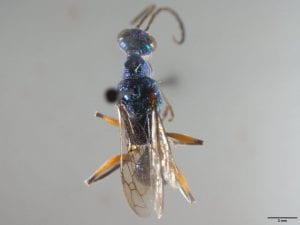
This week’s wasp is the enigma wasp species Orthogonalys pulchella, a strange little insect of the family Trigonalidae! This species was first described by Cresson in 1867, and occurs throughout the eastern United States and eastern Canada, although species in this genus can be found throughout much of the world. Trigonalid wasps have a truly unusual lifestyle, even among parasitoid wasps – continue reading to learn more about these crazy creatures!
Taxonomy: This species is a member of the superfamily Trigonaloidea and the family Trigonalidae. The family Trigonalidae is the only family within Trigonaloidea, and contains approximately 100 living species. This small group contains five species that occur in North America, which are placed in four genera. One of these species, Orthogonalys bella, was somewhat-recently described in 2005, meaning there is still much to discover about this group!
Identification: The family Trigonalidae is recognized by a handful of features, including a small lobe on the face which covers the base of the antennae, the presence of ten closed cells on the forewings and two on the hindwings, and the presence of small projections on the first four segments of the tarsi. The genus Orthogonalys is separated from the other three

North American trigonalid genera by the long, filiform antennae, which always have a light band near the median, and the three-segmented hind trochanters. Orthogonalys pulchella can easily be separated from the other North American species of the genus, Orthogonalys bella, by the overall coloration of the body. In O. pulchella, the body has many yellow to brown accents, while in O. bella, the body is mostly black. Many species of this family are mimics of ichneumonids and other wasps, meaning careful attention to detail is important!
Natural History: Trigonalid wasps have some incredibly atypical lifestyles. Many species are parasitoids of social vespid wasps, sawflies, or caterpillars. However, eggs are not typically laid within hosts as they are in other parasitoid wasps. Instead, they are laid on plant matter, where they remain dormant. Successful eggs must then eaten by herbivorous insects, including caterpillars. Once the eggs have been consumed, they lay completely dormant (and remain undigested) until another parasitoid or predator targets the herbivorous primary host. The trigonalid then parasitizes this secondary insect!

Within this system, the ultimate and true host of the trigonalid is chosen somewhat chaotically. Some species are known from a wide array of hosts, even across insect orders! Despite this bizarre lifestyle, some species are true parasitoids of sawflies.
As a result, the biology of this group is truly cluttered and confusing. The evolutionary processes involved in producing this lifestyle are entirely unknown, although suffice it to say that this mechanism is truly unique amongst wasps!
View This Species On:
BugGuide: https://bugguide.net/node/view/132678
iNaturalist: https://www.inaturalist.org/taxa/495349-Orthogonalys-pulchella
References:
- Aguiar, A. P., Deans, A. R., Engel, M. S., Forshage, M., Huber, J. T., Jennings, J. T., … & Miko, I. (2013). Order Hymenoptera. In: Zhang, Z.-Q.(Ed.) Animal Biodiversity: An Outline of Higher-level Classification and Survey of Taxonomic Richness (Addenda 2013). Zootaxa, 3703(1), 51-62.
- Carmean, D., & Kimsey, L. (1998). Phylogenetic revision of the parasitoid wasp family Trigonalidae (Hymenoptera). Systematic Entomology, 23(1), 35-76.
- Goulet, H., Huber, J. T. (1993). Hymenoptera of the world: An identification guide to families. Ottawa: Research Branch Agriculture Canada.
- Smith, D. R., & Stocks, I. C. (2005). A new trigonalid wasp (Hymenoptera: Trigonalidae) from eastern North America. Proceedings of the Entomological Society Of Washington, 107(3), 530.



 Figure 1: Ibalia anceps female, lateral habitus
Figure 1: Ibalia anceps female, lateral habitus Figure 2: Ibalia anceps female, dorsal habitus
Figure 2: Ibalia anceps female, dorsal habitus Figure 3: Ibalia anceps female, anterior view
Figure 3: Ibalia anceps female, anterior view Figure 4: Ibalia anceps female, face
Figure 4: Ibalia anceps female, face Figure 5: Ibalia anceps forewing, indicating the radial cell (in red)
Figure 5: Ibalia anceps forewing, indicating the radial cell (in red)







